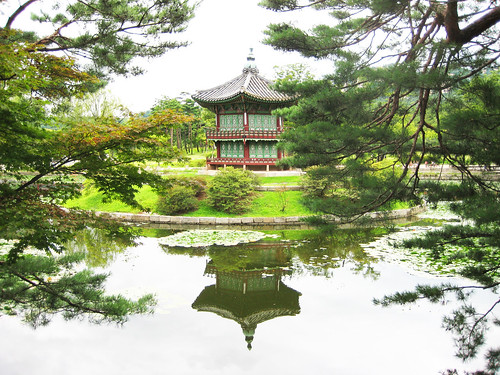
Hyangwonjeong @ Gyeongbokgung
The first of the vacation posts! (Technically, it's the third of the vacation posts, but it's the first of the post-vacation wrap up posts, i.e. the part where I feel guilty for ignoring my blog for weeks and spam it with photos. Lots and lots of photos.) Sarah arrived on a Friday and the next day, we headed into Seoul for some shopping and sight seeing. We spend a few hours looking at fans and posing for (other people's) pictures in Insa-dong, then walked to the nearby Gyeongbokgung, or the Palace Greatly Blessed by Heaven.
Gyeongbokgung was built in 1395, shortly after the foundation of the Josoen Dynasty, and served as the main palace until 1592, when the Japanese burnt it down. It was rebuilt 300 years later, only to be destroyed by the Japanese again in 1915. It's a story that's repeated throughout Korea; this was once a site of important cultural patrimony until the Japanese burnt it to the ground. I had no idea the Japanese were so arson prone. Restoration of Gyeongbokgung began twenty years ago and it's a lovely, if no longer authentic, site. (In all honestly, I spent enough time in the museum and archaeology business to know how very few "historic sites" are truly authentic and Gyeongbokgung is at least a well done restoration.)

We arrived at Gyeongbokgung in time to see the changing of the guard ceremony. Maybe it's my own history in historic reenactment, but I always love watching other people suffer through it. I especially enjoyed the costumes (I know that one's pure schadenfreude), the weapons and the dude playing a conch shell.
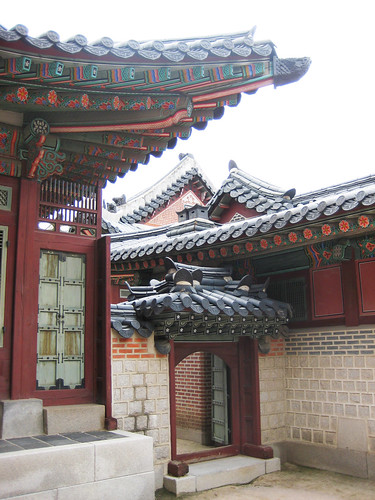
One of the things I like the most about the Korean palaces are the roofs. The mixture of the upturned roofs and the brightly painted eves create an appealing and quintessentially Korean image. (I do apologize for sounding like a travel guide. I can't help it; I just really like traditional Korean roofs.)
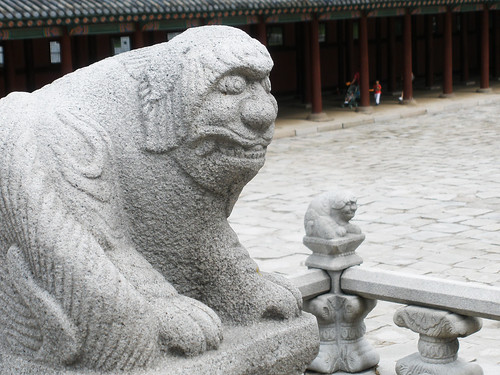
The main throne hall of Gyeongbokgung, Geunjeongjeon, is surrounded by a two tier terrace decorated with statues of the Chinese zodiac and the guardian spirits. This one is, I think, a tiger, or possible Baekho, guardian of the west. The palace guidebook and my two week only memory are unclear as to which.
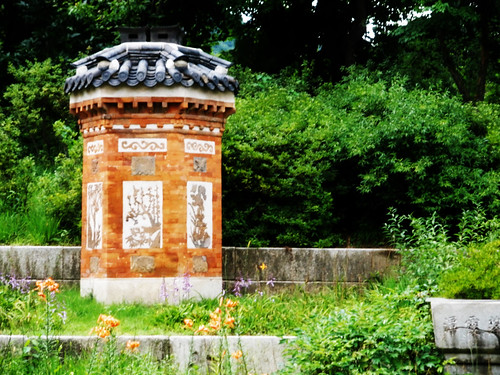
Korean buildings are heated by ondol, a system of heated passageways underneath the floor. Traditionally smoke from a wood fire was used to heat the passageways, while modern ondol systems are a series of pipes filled with hot water. (The heater in my apartment didn't work particularly well, so this winter my apartment was heated solely by my building's ondol.) This is the chimney for the ondol system at Gyotaejeon, the queen's primary residence.

Behind the main palace is Hyangwonjeong, a small pagoda on an island in the middle of a square pond. The lily pads were so thick that the ducks in the pond had to waddle across them to reach open water. Hyangwonjeong is a well known symbol of the Joseon dynasty - I've seen multiple pictures of it - but I didn't know where it was until I visited Gyeongbokgung.

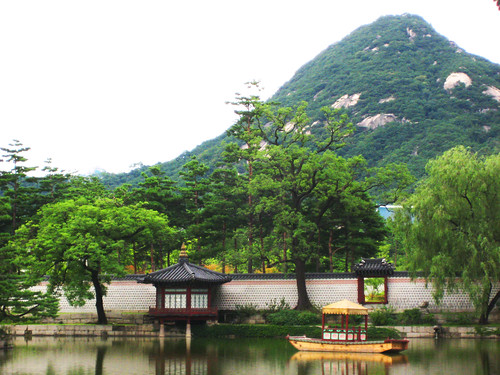
Gyeonghoeru Pavilion was built as a spot for the king to entertain guests and throw lavish parties. It's surrounded by a pond, and the king and his entourage would boat around the pavilion during the parties while Mount Inwangsan towered over them. I'll be honest, I would have totally partied with the Joseon king.
The full set of photos are here.

No comments:
Post a Comment